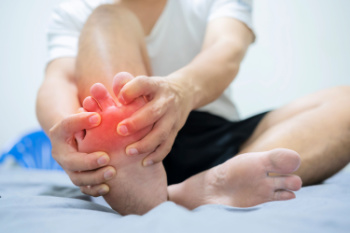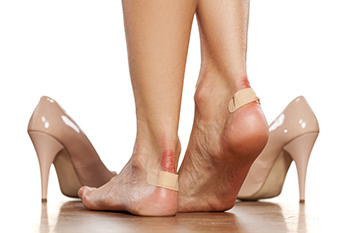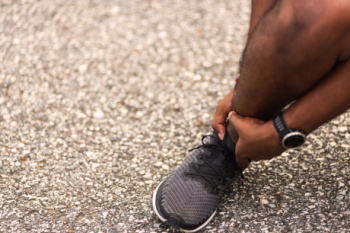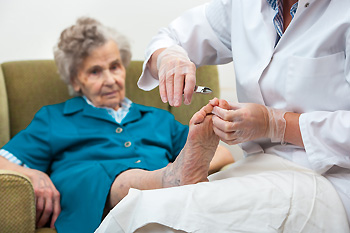Blog
Items filtered by date: February 2024
What Causes Toe Pain
 Toe pain can significantly disrupt day to day activities, so it is important to gain clarity on the source of the pain to get proper treatment. One common reason for toe pain is wearing improper footwear. Shoes that are too tight or narrow lead to pressure and discomfort on the toes. If there is pain surrounding the edge of the toenail, a potential cause of the pain is an ingrown toenail. Athletes may experience toe pain due to repetitive stress or strain on the feet during sports activities. Conditions like bunions or hammertoes, where the bones or joints in the toes become misaligned, can also cause significant discomfort. Sudden and severe pain in the big toe joint can be a symptom of gout. There are also other possible causes of toe pain. If you are experiencing persistent toe pain, it is suggested you schedule an appointment with a podiatrist who can identify the source and offer correct treatment methods.
Toe pain can significantly disrupt day to day activities, so it is important to gain clarity on the source of the pain to get proper treatment. One common reason for toe pain is wearing improper footwear. Shoes that are too tight or narrow lead to pressure and discomfort on the toes. If there is pain surrounding the edge of the toenail, a potential cause of the pain is an ingrown toenail. Athletes may experience toe pain due to repetitive stress or strain on the feet during sports activities. Conditions like bunions or hammertoes, where the bones or joints in the toes become misaligned, can also cause significant discomfort. Sudden and severe pain in the big toe joint can be a symptom of gout. There are also other possible causes of toe pain. If you are experiencing persistent toe pain, it is suggested you schedule an appointment with a podiatrist who can identify the source and offer correct treatment methods.
Toe pain can disrupt your daily activities. If you have any concerns, contact Stephanie Tine, DPM of Flamingo Foot and Ankle. Our doctor can provide the care you need to keep you pain-free and on your feet.
What Causes Toe Pain?
Most severe toe pain is caused due to a sports injury, trauma from dropping something heavy on the toe, or bumping into something rigid. Other problems can develop over time for various reasons.
Toe pain can be caused by one or more ailments. The most common include:
- Trauma
- Sports injury
- Wearing shoes that are too tight
- Arthritis
- Gout
- Corns and calluses
- Hammertoe
- Bunions
- Blisters
- Ingrown toenails
- Sprains
- Fractures (broken bones)
- Dislocations
When to See a Podiatrist
- Severe pain
- Persistent pain that lasts more than a week
- Signs of infection
- Continued swelling
- Pain that prevents walking
Diagnosis
In many cases the cause of toe pain is obvious, but in others, a podiatrist may want to use more advanced methods to determine the problem. These can range from simple visual inspections and sensation tests to X-rays and MRI scans. Prior medical history, family medical history, and any recent physical traumatic events will all be taken into consideration for a proper diagnosis.
Treatment
Treatments for toe pain and injuries vary and may include shoe inserts, padding, taping, medicines, injections, and in some cases, surgery. If you believe that you have broken a toe, please see a podiatrist as soon as possible.
If you have any questions please feel free to contact our office located in Fort Lauderdale, FL . We offer the newest diagnostic tools and technology to treat your foot and ankle needs.
Plantar Warts Can Be Treated!
Shoe Choices That May Lead to Foot Blisters

The selection of appropriate footwear plays a pivotal role in maintaining foot health and comfort, yet certain shoe types can inadvertently contribute to the formation of painful blisters. Wearing ill-fitting shoes, characterized by tightness or inadequate space for the toes to move freely, often creates friction and pressure points against the skin, leading to blister formation. High heels, particularly those with a narrow toe box and stiff materials, force the feet into unnatural positions, increasing the risk of blisters on the toes and heels due to constant rubbing and pressure. Similarly, shoes with rough seams, abrasive materials, or poorly cushioned interiors can result in friction and irritation, promoting blister development. Additionally, shoes made from non-breathable materials trap moisture and heat, creating a conducive environment for blister-causing friction and skin irritation. If you are seeking more information about what to look for in shoes that can prevent blisters, it is suggested that you consult a podiatrist who can provide you with useful tips.
Blisters are prone to making everyday activities extremely uncomfortable. If your feet are hurting, contact Stephanie Tine, DPM of Flamingo Foot and Ankle. Our doctor can provide the care you need to keep you pain-free and on your feet.
Foot Blisters
Foot blisters develop as a result of constantly wearing tight or ill-fitting footwear. This happens due to the constant rubbing from the shoe, which can often lead to pain.
What Are Foot Blisters?
A foot blister is a small fluid-filled pocket that forms on the upper-most layer of the skin. Blisters are filled with clear fluid and can lead to blood drainage or pus if the area becomes infected.
How Do Blisters Form?
Blisters on the feet are often the result of constant friction of skin and material, usually by shoe rubbing. Walking in sandals, boots, or shoes that don’t fit properly for long periods of time can result in a blister. Having consistent foot moisture and humidity can easily lead to blister formation.
Prevention & Treatment
It is important to properly care for the affected area in order to prevent infection and ease the pain. Do not lance the blister and use a Band-Aid to provide pain relief. Also, be sure to keep your feet dry and wear proper fitting shoes. If you see blood or pus in a blister, seek assistance from a podiatrist.
If you have any questions, please feel free to contact our office located in Fort Lauderdale, FL . We offer the newest diagnostic and treatment technologies for all your foot care needs.
Root Causes of Heel Pain

Understanding the root causes of heel pain is essential for effective treatment. Mechanical factors such as acute injuries, like a ruptured plantar fascia, are common causes of heel pain. Degenerative conditions, such as plantar fasciitis or calcaneal stress fractures, also may significantly affect the heel. Neurologic causes, including nerve compression and inflammation of the Achilles tendon, can cause heel discomfort, especially during activities. Rheumatologic conditions, such as psoriatic arthritis or rheumatoid arthritis, can lead to chronic inflammation and persistent heel pain. Differentiating between these causes is vital for tailored treatment plans, which may involve orthotic devices, certain exercises, or reducing pressure on affected tendons during acute phases. Additionally, addressing contributing factors like foot pronation, inadequate footwear, or high-impact physical activities is important for long-term management. If you are experiencing heel pain that interferes with your daily activities, it is suggested that you schedule an appointment with a podiatrist for a full exam and diagnosis, followed by suggesting correct treatment options for you.
Many people suffer from bouts of heel pain. For more information, contact Stephanie Tine, DPM of Flamingo Foot and Ankle. Our doctor can provide the care you need to keep you pain-free and on your feet.
Causes of Heel Pain
Heel pain is often associated with plantar fasciitis. The plantar fascia is a band of tissues that extends along the bottom of the foot. A rip or tear in this ligament can cause inflammation of the tissue.
Achilles tendonitis is another cause of heel pain. Inflammation of the Achilles tendon will cause pain from fractures and muscle tearing. Lack of flexibility is also another symptom.
Heel spurs are another cause of pain. When the tissues of the plantar fascia undergo a great deal of stress, it can lead to ligament separation from the heel bone, causing heel spurs.
Why Might Heel Pain Occur?
- Wearing ill-fitting shoes
- Wearing non-supportive shoes
- Weight change
- Excessive running
Treatments
Heel pain should be treated as soon as possible for immediate results. Keeping your feet in a stress-free environment will help. If you suffer from Achilles tendonitis or plantar fasciitis, applying ice will reduce the swelling. Stretching before an exercise like running will help the muscles. Using all these tips will help make heel pain a condition of the past.
If you have any questions please contact our office located in Fort Lauderdale, FL . We offer the newest diagnostic and treatment technologies for all your foot and ankle needs.
Foot Health Tips for Seniors

Maintaining healthy feet as you age is an important way to improve overall well-being. Normal changes like foot widening, thinning skin, and reduced padding are common in older adults. However, wearing proper footwear, including well-fitted shoes and custom orthotic inserts, can help to alleviate discomfort. Establishing a regular foot care routine, including washing, moisturizing, and trimming the toenails, is essential. Engaging in light exercise promotes circulation and flexibility, benefiting foot health as well as overall well being. Be vigilant for abnormal signs, such as persistent sores, joint pain, bunions, hammertoes, or frequent falls, which may indicate underlying health issues that require medical attention. Regular podiatric check-ups are a good way to monitor foot health and address concerns as they arise. Opt for foot-friendly shoes with a wide toe box and low heels to reduce pressure and minimize the risk of falls. For help with any foot problems that arise as you age, it is suggested you schedule regular visits with a podiatrist.
Proper foot care is something many older adults forget to consider. If you have any concerns about your feet and ankles, contact Stephanie Tine, DPM from Flamingo Foot and Ankle. Our doctor can provide the care you need to keep you pain-free and on your feet.
The Elderly and Their Feet
As we age we start to notice many changes in our body, but the elder population may not notice them right away. Medical conditions may prevent the elderly to take notice of their foot health right away. Poor vision is a lead contributor to not taking action for the elderly.
Common Conditions
- Neuropathy – can reduce feeling in the feet and can hide many life-threatening medical conditions.
- Reduced flexibility – prevents the ability of proper toenail trimming, and foot cleaning. If left untreated, it may lead to further medical issues.
- Foot sores – amongst the older population can be serious before they are discovered. Some of the problematic conditions they may face are:
- Gouging toenails affecting nearby toe
- Shoes that don’t fit properly
- Pressure sores
- Loss of circulation in legs & feet
- Edema & swelling of feet and ankles
Susceptible Infections
Diabetes and poor circulation can cause general loss of sensitivity over the years, turning a simple cut into a serious issue.
If you have any questions please feel free to contact our office located in Fort Lauderdale, FL . We offer the newest diagnostic and treatment technologies for all your foot and ankle needs.
Blog Archives
- July 2025
- June 2025
- May 2025
- April 2025
- March 2025
- February 2025
- January 2025
- December 2024
- November 2024
- October 2024
- September 2024
- August 2024
- July 2024
- June 2024
- May 2024
- April 2024
- March 2024
- February 2024
- January 2024
- December 2023
- November 2023
- October 2023
- September 2023
- August 2023
- July 2023
- June 2023
- May 2023
- April 2023
- March 2023
- February 2023
- January 2023
- December 2022
- November 2022
